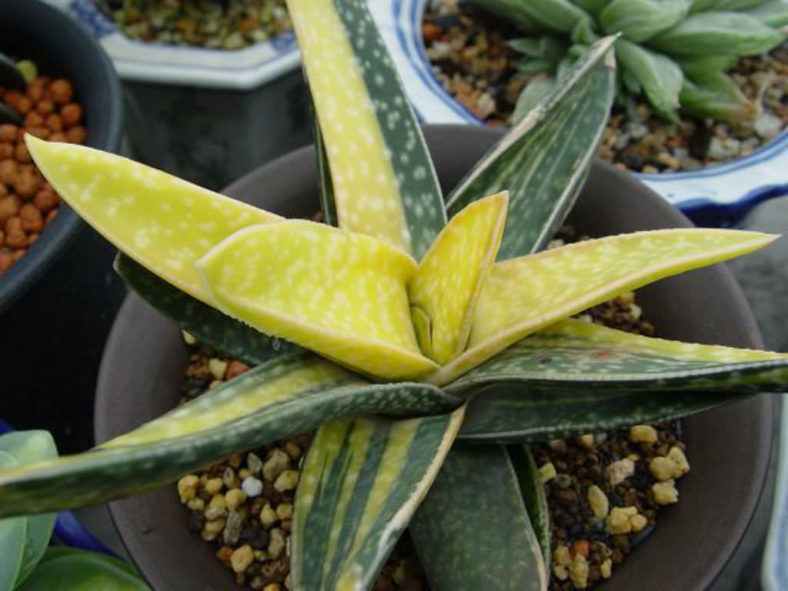The genus Gasteria is named for the sac-like shape of its flowers, which resemble a stomach. The species are native to South Africa, growing in lightly shaded conditions with excellent drainage. As a result, they are adapted to relatively lower light conditions than some more well-known succulents, and they are good houseplants. Depending on the species, leaves are often marked with interesting patterns and coloration.
Growing Conditions
Light: Bright light, but not direct sunlight. These plants grow in similar conditions to Haworthias. White or yellow leaves usually signify too much sun.
Water: Water evenly and generously in the summer, letting the soil dry out between waterings. Reduce watering to every other month in the winter, but do not stop watering. Never allow water to collect in between the leaves.
Temperature: Warmer summers but cool in the winter, down to 50 ˚F (10 ˚C). The leaves might turn a lighter, brighter color during warmer weather, or the plant might flower with small, colorful sac-shaped flowers.
Soil: Use a soil mix for succulents or very fast-draining potting soil mixed with sand.
Fertilizer: Fertilize during the summer growing season with a fertilizer for cacti and succulents. Do not feed during the winter.

Propagation
Gasterias are usually propagated at repotting time using offsets from the mother plant or leaf cuttings, depending on the species.
When taking offsets, use a sharp knife or snippers and cut as close to the mother stem as possible to include as many roots as possible. Then, allow the offset to dry briefly before repotting it. Next, pot the offsets in a small pot, use the same soil as the mother plant, and put it in a warm, bright spot and adequately water.
Repotting
Gasterias are small, shallow-rooted, and relatively slow-growing plants. Therefore, they are often grown in small clusters in wide, shallow dishes. Over time, clusters will naturally enlarge as the mother plant sends off small plantlets. When the cluster has outgrown its container, repot into a new wide and shallow dish with fresh potting soil in the spring or early summer. This is also the time to take offsets for propagation.
Grower's Tips
Gasterias are often grouped with Haworthia because they have similar cultural requirements. Both are attractive, small succulents that can tolerate somewhat more shade than many succulents, making them more suitable as houseplants. However, these succulents are susceptible to fungal infections, usually appearing as black spots on the leaves. These result from too much humidity or water on the leaves, but they should not spread too quickly. Gasterias have a natural defense mechanism against such fungal attacks and attack the invading organism and seal off the wounded spot. In general, any place where Haworthia and Aloe thrive will be hospitable to a Gasteria.
Source: about.com
Links
- Back to genus Gasteria
- Succupedia: Browse succulents by Scientific Name, Common Name, Genus, Family, USDA Hardiness Zone, Origin, or cacti by Genus